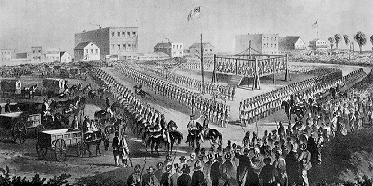A Morning in Mankato, Minnesota
by Doug Linder (2021)

In the parking lot of a Standard Oil station in my hometown
stood a granite monument that said
“Here were hanged 38 Sioux Indians—December 26, 1862.”
That was all it said. Nothing about the Dakota War.
Nothing about the eight hundred lives lost.
Nothing about the white trader who told starving Dakota people “to eat grass.”
Nothing about the massacred farm families,
young girls left disrobed and bloodied on cabin floors.
Nothing about the general who called for extermination of “the wild beasts.”
History is too complicated to be explained on a six-foot high monument.
The gas station is gone now, the monument removed,
a large limestone sculpture of a bison erected in its place.
The patch of land is renamed “Reconciliation Park.”
The theme of the park, engraved on the stone bench on which I now sit,
is “Forgive everyone everything.”
As I think of everything that happened, everything that led to this place,
I feel the bison's cool gaze.
He ambles off in search of fresh grass, or solitude.
Where the bison just stood, a rectangular scaffold rises,
and a thousand soldiers, all in blue, move into position around it.
A military captain leads the thirty-eight Dakota warriors,
their heads covered in white muslin,
up the steps to the scaffold
and to the places assigned for their deaths.
Soldiers hurry to place nooses around each neck.
It’s too much to watch, so I close my eyes and listen.
Listen to the death chant of the warriors: Hi-yi-yi, hi-yi-yi, hi-yi-yi.
Listen as the chanting grows more urgent. Hi-yi-yi! Hi-yi-yi! Hi-yi-yi!
The sound of a drum beat. A second beat.
Then the third, the fatal signal. An axe swings.
The scaffold falls,
and the crowd cheers.
The cheers ring down the Minnesota River Valley,
rise up the over the bluffs, spill onto the prairie,
and mingle with the sound of the lonesome wind.
